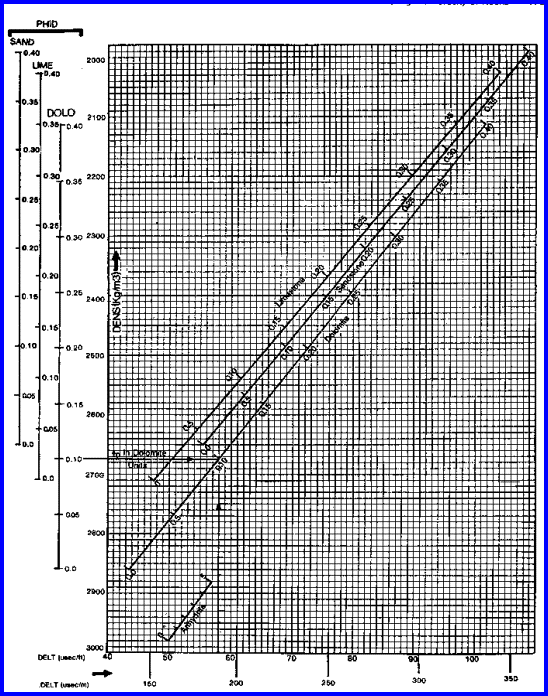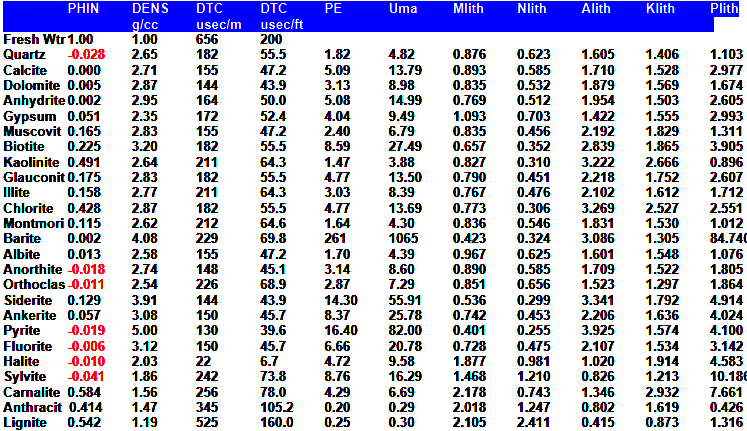|
 Sonic DENSITY Crossplot
Sonic DENSITY Crossplot
The sonic density crossplot model is used to estimate porosity
when the density neutron crossplot method cannot be used. The method
works well when shale volume, matrix rock properties, and
sonic compaction effects are
accurately known. If both density and neutron logs are available, a superior
model that does not require matrix rock properties is the
Shale Corrected Density Neutron
Complex Lithology Crossplot Method. The Meta/Kwik
spreadsheet for this model is available at
Downloads and Spreadsheets.
 Sonic DENSITY CrossplOT
POROSITY
Sonic DENSITY CrossplOT
POROSITY
The sonic density crossplot method involves the simultaneous solution
of the sonic and density response equations for porosity. They
are similar in form to the density neutron pair, and will not
be repeated here.
The sonic density crossplot works best in shaly sands with no
gas. The resolution is poor in carbonates and gas will make the
result too high. The equations are shown graphically below the
math.
Calculate compaction correction.
1: KCP = max (1, DTCSH / (100 + 228 * (IF DEPTHUNIT$ = "METRIC")))
Calculate sonic shale porosity and total porosity.
2: PHISSH = (DTCSH - DTCMA) / (DTCW - DTCMA) / KCP
3: PHIS = (DTC - DTCMA) / (DTCW - DTCMA) / KCP
Calculate effective porosity:
4: PHIxsd = (PHID * PHISSH - PHIS * PHIDSH) / (PHISSH - PHIDSH)
Where:
DTCSH = sonic shale value for compaction correction (usec/ft or
usec/m)
KCP = compaction factor (fractional)
DTC = sonic log reading (usec/ft or usec/m)
DTCMA = travel time in rock matrix (usec/ft or usec/m)
DTCSH = sonic log reading in shale (usec/ft or usec/m)
DTCW = travel time in water (usec/ft or usec/m)
PHID = density log reading (fractional)
PHIDSH = density shale point (fractional)
PHIS = porosity from sonic log (fractional)
PHISSH = sonic porosity in shale (fractional)
PHIxsd = porosity from density sonic crossplot (fractional)
 COMMENTS:
COMMENTS:
This method is pictured in below.

Chart for Sonic Density Porosity Model - shale corrected data
must be entered
This
method is analogous to the density neutron shaly sand method. It does not work well in mixed lithology, such
as limestone, dolomite and anhydrite mixtures. This method also
does not use the volume of shale (Vsh) determined by the analyst,
but uses the implicit shale correction determined by the sonic
shale point (PHISSH) and the density shale point (PHIDSH). The
sonic density crossplot should not be used in gas zones, since
both logs can read too high due to gas effect.
If a matrix offset is required for the density log, use the method
described in HERE.
 RECOMMENDED PARAMETERS:
RECOMMENDED PARAMETERS: |
|
| |
Range |
Default |
| PHIDSH |
-0.03
to +0.20 |
0.00 |
| DTCSH
(English)
|
75
to 140 |
100 |
DTCSH
(Metric)
|
225
to 460 |
328 |
 Porosity From the Sonic Density Log (Hunt-Raymer
Method)
Porosity From the Sonic Density Log (Hunt-Raymer
Method)
Calculate shale corrected density and sonic log readings and convert
to English units.
5: PHIdc = PHID - Vsh * PHIDSH
6: DTCc = (DTC - Vsh * (DTCSH - DTCMA))
/ KX2
7: DENSc = PHIdc * KD1 + (1 - PHIdc) * KD2
Where:
KD1 = 1.00
KD2 = 2.65 for Sandstone Units
KD2 = 2.71 for Limestone Units
KX2 = 3.281 for Metric Units
KX2 = 1.00 for English Units
Calculate velocity data from sonic travel time data.
8: VELOGc = 10 ^ 6 / DTCc
9: VELMA = 10 ^ 6 / DTCMA
10: VELW = 10 ^ 6 / DTCW
Calculate sonic porosity.
11: C = 1 - (VELOGc / (VELMA * ((DENSMA / DENSc) ^ 0.5))) ^ (1
/ 1.9)
12: D = DTCc ^ 2 - DENSc * (DTCMA ^ 2) / DENSMA
13: E = DENSc * (DTCW ^ 2) / DENSW - DENSc * (DTCMA ^ 2) / DENSMA
14: IF C <= 0.37
15: THEN PHIxhr = C
16: OTHERWISE PHIxhr = ((0.47 - E / D) / 0.1) * E / D + ((0.37
- C) / 0.1) * C
Where:
C = intermediate term
D = intermediate term
DTC = sonic log reading in zone of interest (usec/ft or usec/m)
DTCc = sonic log reading corrected for shale (usec/ft or usec/m)
DTCMA = sonic log reading in l00% matrix rock (usec/ft or usec/m)
DTCSH = sonic log reading in l00% shale (usec/ft or usec/m)
DTCW = sonic log reading in 100% water (usec/ft or usec/m)
DENSc = density log reading corrected for shale (gm/cc)
DENSMA = matrix density (gm/cc)
E = intermediate term PHID = density log reading in zone of interest
(fractional)
PHIDSH = density log reading in 100% shale (fractional)
PHIxhr = porosity from sonic log by Hunt-Raymer crossplot (fractional)
VELOGc = sonic velocity log reading corrected for shale (ft/sec
or m/sec)
VELMA = sonic velocity log reading in l00% matrix rock (ft/sec
or m/sec)
VELW = sonic velocity log reading in 100% water (ft/sec or m/sec)
Vsh = shale volume (fractional)
 COMMENTS:
COMMENTS:
The Hunt-Raymer equations for density sonic crossplot porosity are an extension of
their work for the sonic log. The results are
too high in gas and can be corrected by a proper choice of DENSW
and DELTW. The method is not universally applicable and should
be tested in each area before use.
 RECOMMENDED PARAMETERS:
RECOMMENDED PARAMETERS:
Range Default
PHIDSH -0.03 to +0.20 0.00
DELTSH (English) 75 to 140 100
DTCSH (Metric) 225 to 460 328
 NUMERICAL EXAMPLE:
NUMERICAL EXAMPLE:
1. Sonic Density Crossplot - data from Sand "D"
DTC = 300 usec/m
PHID = 0.12
DTCSH = 328 usec/m
PHIDSH = 0.03
Vsh = 0.33
DTCW = 616
DTCMA = 182
KCP = 1.00
no matrix offset
PHISSH = (328 - 182) / (616 - 182) / 1.0 = 0.33
PHIS = (300 - 182) / (616 - 182) / 1.0 = 0.27
PHIxsd = (0.12 * 0.33 - 0.27 * 0.03) / (0.33 - 0.03) = 0.105
Vsh was 0.48 using this data, but Vsh from GR is
only 0.33. Therefore, porosity may be too low due to the shale
correction built into this method.
2. Hunt-Raymer Sonic Density Crossplot - data from Sand "D"
Vsh = 0.33
PHIdc = 0.12 - 0.33 * 0.03 = 0.11
DTCc = (300 - 0.33 * (328 - 182)) / 3.28 = 76.8 usec/ft
DENSc = 0.11 * 1.00 + (1 - 0.11) * 2.65 = 2.47
VELOGc = 10 ^ 6 / 76.8 = 13020 ft/sec
VELMA = 10 ^ 6 / 55.5 = 18020 ft/sec
VELW = 10 ^ 6 / 188.0 = 5320 ft/sec
C = 1 - (13020 / (18020 * ((2.65 / 2.47) ^ 0.5))) ^ (1 / 1.9)
= 0.173
PHIxhr = 0.173
This is considerably higher than the standard sonic density crossplot
which over corrected for shale in this example.
 MATRIX ROCK PROPERTIES
MATRIX ROCK PROPERTIES


|





